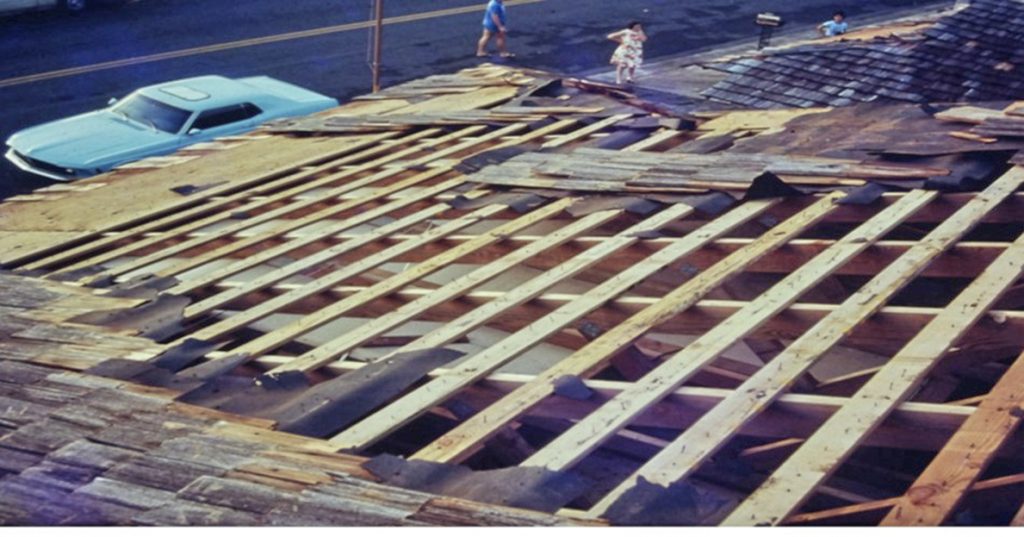
Craig Gima
When Hurricane Iwa hit Hawai`i in 1982, Gerry Silva huddled with his family under the dining room table in his Windward Oahu house as the winds and rains raged outside.
One of his kids noticed water coming into the home and told Silva, “Hey dad, it’s raining in the house.”
“We’re in a two-story house, the only way that would happen is if our roof came off,” Silva replied.
Silva and his family survived the storm, but their home needed lots of repairs.
Ever since then, Silva, an AARP volunteer speaker, has shared his personal story to teach others about hardening your home to survive a hurricane and being prepared for any disaster.

AARP volunteer Gerry Silva’s roof after Hurricane Iwa hit Oahu (Photo: AARP)
The beginning of hurricane season in the Atlantic and Central Pacific on June 1 and in the Eastern Pacific on May 15 is a good reminder to review your disaster plan and emergency kit supplies. Rotate food items, water and prescription medicines that are near their expiration dates. Make sure everyone is aware of what to do if a disaster strikes, how to communicate and how to let everyone know you are safe.
Don’t have a disaster plan or emergency kit? Now is the time to create a plan and get ready to survive a hurricane or any other disaster. Resources on how to plan for a disaster and what should be in your emergency kit are available online at the FEMA website (ready.gov) and the Be Red Cross ready section of the American Red Cross website (redcross.org).
It’s especially important that older Americans and caregivers of older adults have a disaster plan and emergency supplies of medications, medical equipment, batteries, food, water, can openers, contact phone numbers and cash on hand before a disaster.
If you’re a caregiver with a loved one in a nursing home or care home, find out what their disaster plan is and what help might be needed if they have to evacuate the home or if electricity is out for an extended period.
Is the plan workable?
Caregivers need to build a team because one person cannot do it alone in a disaster and its aftermath. What if you are not home when a disaster strikes? Are there neighbors or friends who live close by who can check on them? Those who care for loved ones with dementia will need help keeping their loved one calm and watching them to make sure they don’t wander away.
Label a loved one’s clothes with your contact information so if they do get lost, responders will know where they belong. The Alzheimer’s Assn. has additional tips for caregivers to prepare for disaster at alz.org/help-support/caregiving/safety/in-a-disaster.
Do you know where you will shelter in a storm or other emergency? If you live in a concrete building and are not on the ground floor, the best place to ride out a storm or survive a tsunami may be to shelter in place. But that might not be the best place to be in an earthquake. Maybe a relative or friend has a home that’s been hardened to survive a hurricane and has emergency supplies. Will there be room to shelter there? Make a plan and find out in advance.
If you become separated from your loved ones, do you have a place to meet in the aftermath of a disaster where you can reunite or at least leave a message?
A communications plan is part of disaster planning.
Community leaders, elected officials and volunteers can help neighborhoods organize and prepare for a disaster and survival after a disaster. AARP, working with FEMA, has created a guide to help community leaders organize and better prepare and protect older residents in a disaster. The guide is available at aarp.org/livable-communities/tool-kits-resources/info-2022/aarp-disaster-resilience-tool-kit.html.
Everyone needs to do their part in planning to protect yourself and your loved ones and in checking on and helping neighbors, friends and relatives who may need help in an emergency.
We all need to plan and prepare. Our AARP volunteer, Gerry Silva, is a nice guy. But he doesn’t have room for everybody under his dining room table in a storm.
Craig Gima is the communications director for AARP Hawai’i.



